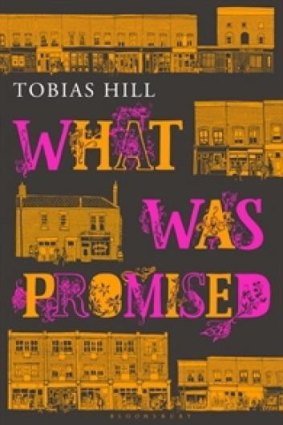By Reviewer: Andrew Riemer
Fiction
What Was Promised
TOBIAS HILL
Bloomsbury Circus, $29.99
Tobias Hill’s novel begins with a Dickensian flourish: a raw, foggy March day in the East End of London in 1948. A crowded street market is coming to an end in Columbia Road in Shoreditch. We catch glimpses of the people whose lives will be chronicled in 20-year leaps over the course of this intricate novel.

What Was Promised, by Tobias Hill.
Three couples occupy the centre of Hill’s busy canvas. Michael and Mary Lockhart are from Birmingham. We learn why Michael, a stallholder with a sideline in received goods, needs a stout stick to support him. Solly Lazarus, a watchmaker, and his wife Dora are refugees from Danzig – Gdansk by the time the story begins in 1948. Clarence Malcolm (the ‘‘Banana King’’, except that bananas are in very short supply) and his wife Bernadette are from Jamaica; they and their son Jem are the only coloured people in that part of the East End, just as Solly and Dore are among the handful of Jews in Shoreditch.
The first part of Hill’s novel is set against the cycle of the seasons in 1948. Its second part spans the summer and autumn of 1968. This section is concerned mostly with the Lockharts’ two daughters, Florence and Iris, and with Jem Malcolm and the young man known only as Pond, whom Solly and Dora took under their wing 20 years earlier when they found him wandering among the rubble of bomb sites. The final part covers one day in 1988, the day of Mary Lockhart’s funeral.
Hill, who was born in London in 1970, is a novelist, poet and children’s author. His novels have received considerable critical praise – A.S. Byatt, for one, regards him as one of the most gifted of Britain’s younger writers.
Hill’s novels are admirably versatile in ambition. Most are structurally complex and adventurous. His first novel, Underground, consists of chapters set in London’s underground rail system alternating with glimpses of life in Communist Poland. The Cryptographer is set in the very near future, at a time when money has been replaced by electronic currency. The Hidden is an account of the adventures of young archaeologists while excavating the sparse remains of Sparta.
Concealment – things hidden or things buried by time – seems to be one of Hill’s chief preoccupations. Several episodes in Underground are set in disused stations and corridors of the Tube. The Cryptographer tells of the way information is encrypted not merely in codes and formulae but in the DNA of plants and perhaps even that of human beings. Besides the pits and trenches of the excavations in The Hidden, that novel’s improbable climax is played out in a near-inaccessible cave.
What Was Promised deals with such matters more subtly, yet several of the major characters are responsible for acts of concealment. None more so than Michael Lockhart with his limp and his disfigured face. I don’t want to give too much away because this novel, like Hill’s earlier books, reveals a fondness for surprises that often detracts from the strength of his writing. This much may be said: in his adolescence Michael, a deeply flawed personality, suffered a devastating illness that marked him for life and was probably instrumental in fashioning his fundamentally secretive – and ultimately criminal – personality.
Hill is also fond of drawing parallels between the often convoluted plots of his novels and ancient myths. Underground makes clear gestures towards the myth of Orpheus’ quest for his wife Eurydice. The Cryptographer glances at the legend of the Minoan labyrinth. Not unexpectedly, The Hidden is filled with accounts of the grim rituals of ancient Sparta.
The last section of What Was Promised, the day of Mary Lockhart’s funeral, bears the title The Fisher King. This reference to the Arthurian legend – together with an extended report of a troubling dream – identifies how the now-wealthy but profoundly lonely and embittered Michael, seems to preside over a contemporary Wasteland. Estranged from his daughters, responsible for the Malcolms' great suffering, mourning the wife who stood by his side in spite of his misdeeds, Michael is an impressively haunted figure in the closing chapters.
One aspect of Hill’s ambition in this novel seems not to have been fully realised. As the title suggests, Hill appears to be concerned with the frustration of Britain’s hopes and aspirations after World War II. The three years, 20 years apart, of the novel’s focus mark, respectively, the beginnings of the welfare state in the late 1940s; the left-wing agitation and hopes of 1968; and triumph of Thatcherism in the second half of the 1980s. Yet this concern remains no more than a potential in an otherwise richly-textured and absorbing novel – though one that relies too heavily, at times, on novelettish cliches.